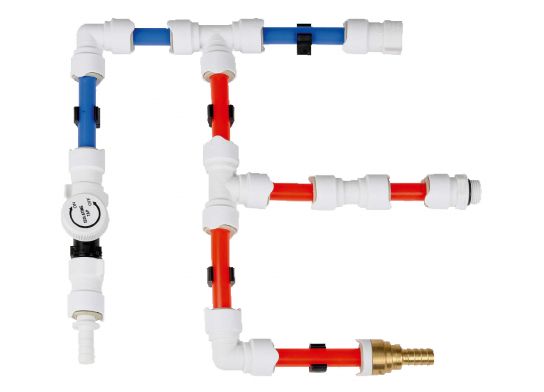June 27, 2016
Before we left California, we installed all new fresh water plumbing. The old polyester reinforced clear PVC tubing in common use was very old and home to, I’m sure, a multitude of algae species. It seemed that everyone was going with the newfangled plastic quick-connect system. It looked to me like it had a lot of advantages:
Easy to install
Very easy to modify
No boiling water to get hoses off barbs
No hateful house clamps (and cuts from those hateful hose clamps)
Long life and maybe less growth
Color coded for hot and cold
With four years of hindsight, I think all of those assumptions turned out to be correct, but there are some negatives that I didn’t anticipate. Some minor and some really annoying! I share these observations hoping that I’ll save some others these headaches.
First, the kind of fittings and tubing we went with were made by Whale. (I’m not saying there’s any particular problem with the Whale fittings – I think others would have similar issues.) Above is a picture of the fittings and tubing I’m talking about.
Here are the issues we’ve had, one by one.
Incompatible Fittings and Tubing: Don’t expect to be able to buy fittings or tubing compatible with these around the world. Even if the size seems correct and the fittings look right, they might not be compatible. We bought tubing and connectors at Burnsco in New Zealand. Everything went together well but when I turned on the water, the tubing blew out of the fittings.
I measured again, re-inserted the tubing and it happened again. I found little rings that can be inserted to lock the fittings. No help. It turned out that the tubing from some manufacturers is harder or softer than others. The NZ variety that I bought was very hard and the locking clamps in the fittings couldn’t hold the hard tubing. The NZ fittings have metal, rather than plastic clamps inside (at least this is my best guess as to the cause.)
With this in mind, I’d say take plenty of extra fittings and tubing.
Don’t Use on the Suction Side: While these fittings are very good at holding pressure, even a slight vacuum, like on the suction side of your water pump, seems to cause an air leak. This can make it very difficult for the water pump to prime after you run out of water. To combat this, I installed the above mentioned lock rings in all the fittings (negating some of the ease-of-use argument as these are very hard to install). This might have helped a little, but it sure didn’t cure the problem.
We finally ended up moving our fresh water pump to a spot in the bow, right behind our water tanks. I removed all the quick fittings from the inlet side and went back to hose. It made things better, but didn’t fix everything. More needed to be done.
Restricted Flow: It seems to me that this tubing, or maybe, or both, offer more resistance to water flow than my old hose did. On the inlet side, this meant that the pump had to work harder to draw water from the tanks. This is very hard on the pump and is obvious as the pump is louder than it should be and vibrates a lot. On the outlet side it meant that the pressure didn’t reach the fittings furthest away from the pump once water was flowing.
It was so bad that the pump would rapidly cycle when we turned the galley sink on, even at full. We had an accumulator in the system but it was located by our galley sink while our water pump is in the bow. Today, I moved the accumulator tank to a spot right after the pump outlet (probably where it should have been all along) and that helped a lot. Now, when the pump runs, it runs smoothly and continuously until max pressure is reached, as it did with our old tubing.
Noisy: If you’re not careful to anchor the plastic tubing where necessary, it can be pretty noisy. It rattles with the pump cycling and the hard tubing makes a hard noise on the hard hull and cabinetry.
Conclusion:
We’ve been trying to fix the problems caused by my plumbing change for four years – a little at a time. It’s been annoying. I think it’s cost us one FW pump as well.
Would I do it again?: Maybe. I could have avoided some of the problems by not using it on the inlet side of the pump, installing the accumulator at the pump and stocking up on spare fittings and tubing. It is awfully easy to install and if you don’t use the little lock rings, easy to modify. I does make for a clean installation. I feel a little foolish for not realizing there would be a problem on the inlet, but live and learn. And I really hate hose clamps!
P.S. When I was doing some research for this post tonight, I noticed the following on West Marine’s website.
California Prop 65 Warning:
These products may contain bisphenol-A (BPA), a chemical known to the state of California to cause harm to the female reproductive system.
Great, something else to worry about (if I had female reproductive organs, that is)! -Rich






